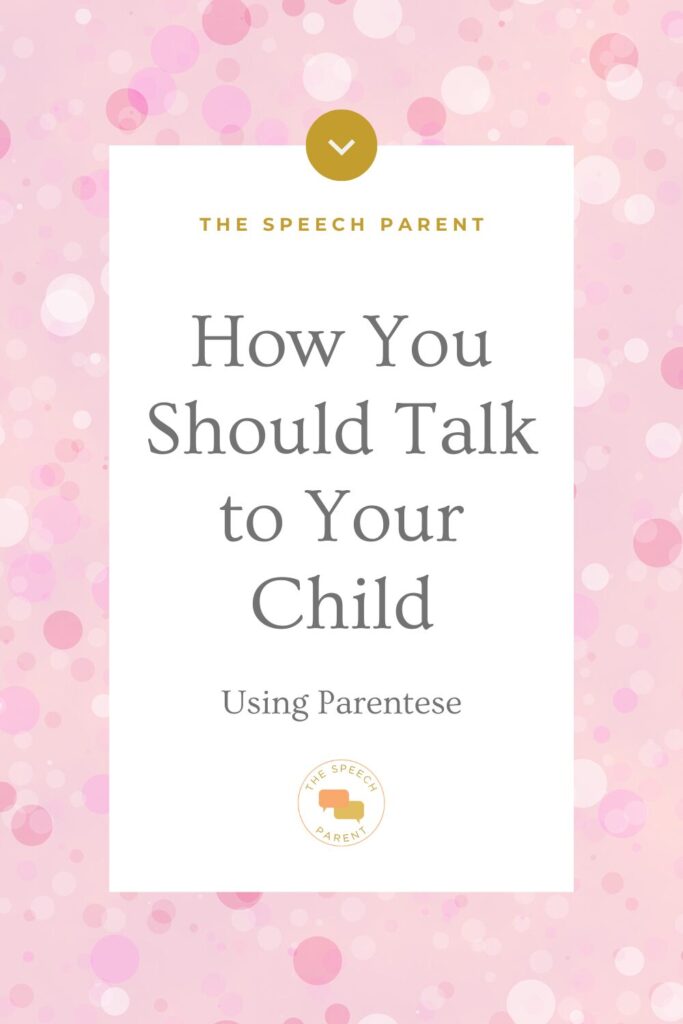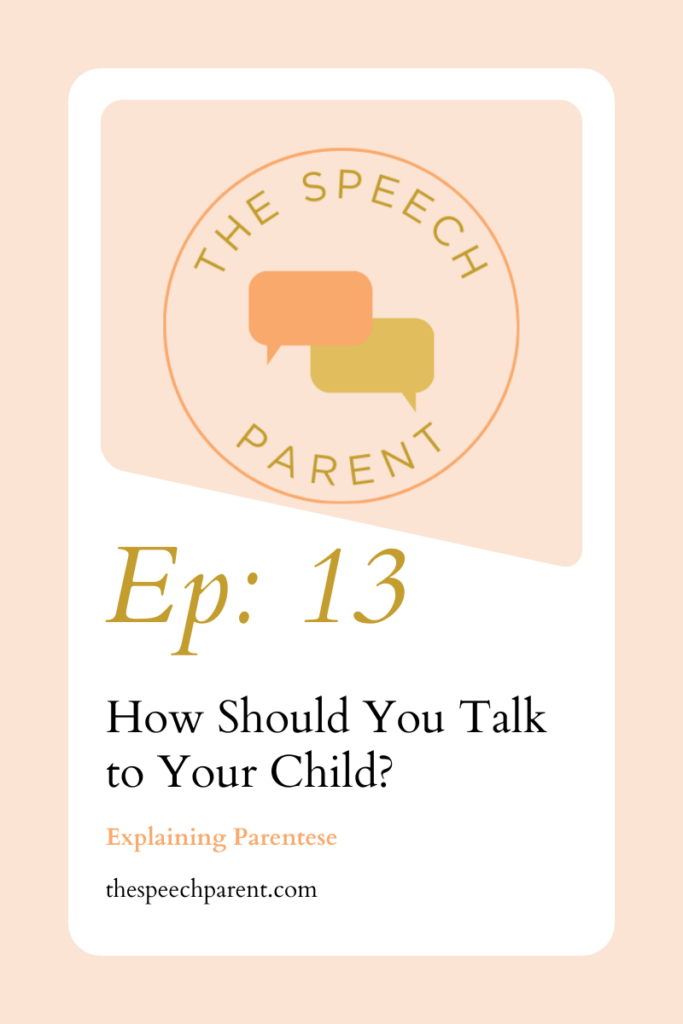Hello hello, welcome back to (reading) another episode of The Speech Parent Podcast, all about parentese!! I’m so glad that you’re here. The past few weeks we’ve been talking allllll about speech therapy strategies that you can use at home. These strategies are specifically used for early intervention language therapy. So working with little kids and getting them to talk more. I use these with babies, toddlers, even preschoolers.
We mostly use them in play, but really we as parents can use them all day long and just incorporate them into our busy lives. So if you haven’t read those blog posts yet, pause here, go back and read the blog posts from episodes 10 and 12, then come back to read this one! Those blog posts are the meat, and this post is just the yummy cheese on top – all about parentese!
How You Should Talk to Your Child Using Parentese
So those blog posts talk about content or WHAT you are saying to your child. I want to spend some time talking about the HOW or how your voice should sound when you’re talking to your young child.
So research has shown that using high pitched, sing songy voice (so basically what Ms. Rachel sounds like if you’ve ever watched her on YouTube) is really great at grabbing the attention of little ones. And we definitely need their attention if we’re going to teach them something, even just us modeling language to them.
Let me illustrate it for you. If I was trying to play with a child totally engrossed in their own toy cars and I just said: Look the car is going down the slide! Ready set go, beep beep go go!
It’s basically just a jumble, word vomit, and not really attention grabbing to them. It’s hard for them to pick up on the vocabulary we’re trying to teach. But now what if I did the same words, but said it with a high pitched, sing songy voice as well as slowing down my rate and really over enunciating my words.
LOOK the car is going doooown the slide! Ready- set- go!!!, beep beep!! go go!
Explaining Parentese
We call talking like this PARENTESE. And yes, it’s a really great strategy, that’s why I’m teaching it to you, but I also want to know that it’s really hard to do for long periods of time – especially if you don’t work with kids or it doesn’t feel very natural. So please don’t feel like you have to talk like this all the time! I recommend just incorporating it into specific play time with your little one. Get on the floor with them, use all of the strategies that you learned in the other episodes, and incorporate parentese then.
The rest of the time, you can sprinkle in parentese as you feel up to it. And if the whole shabang feels like too much, just focus on your rate of speech. Sometimes we talk too fast for our little ones to follow or understand.
One time, when I was in graduate school, I was reading something to the kid I was working with – she was like maybe 4 years old? – anyway I wasn’t thinking much of it just reading like i would normally and my supervisor actually barged into the therapy room to stop me and was like woah woah woah you’re reading way too fast. And I’m so thankful that she had such a big reaction because it really stuck with me to be mindful about my speaking rate or reading rate when I’m working with kids. I know that I talk and read way too fast for them naturally, so I had to learn how to really slow down.
Sing Song Voice and Slowing Down
So try slowing down and really over-enunciating if possible. In our busy busy cultures, it can be hard to do things slowly. It doesn’t always feel natural. But just being mindful of how fast we’re talking can really be beneficial for our kids.
Speaking in PARENTESE, that sing-songy voice where we talk slowly and really enunciate our words: it also helps make things a lot more fun for our kids. And when they’re having fun, it’s easier for us to have fun too.

So my challenge for you today is to try out the sing-songy, slow voice in play or when reading a book to your child and just see how they respond. I bet they will be sooo focused on you and it will be really beautiful to see what they’re able to learn with this new little superpower that you’ve got!
Is Your Child a Gestalt Language Processor?
If you feel like they’re still having a lot of trouble as you incorporate the strategies you’ve learned in the other episodes: so self-talk, parallel-talk, verbal routines, wait time, – if they don’t seem to be helping then it’s possible there are more things that we need to address with your child or a different way that we need to target language. A lot of kids that I work with are gestalt language processors, which means they learn language as whole units or chunks. And we work with these kids differently, and so should you as a parent, and so should your kids speech therapist.
If you want to learn more about gestalt language processing or see if your child is a gestalt language processor, I have a workshop talking allllll about it that’s coming out soon. So you can be the first to hear when it releases and get it FOR FREE by going to thespeechparent.com/waitlist to join the waitlist for the Gestalt language processing workshop!
I’m so excited about that workshop and to see how it helps other speech parents. I’m also excited to see how YOU use today’s strategy of parentese to talk to your kids in a way that best boosts their language development! I would love love to hear from you about how these strategies are working for you or answer ANY questions – so please send me a dm on social media (@thespeechparent) or email me at thespeechparent@gmail.com
Thanks for listening! See you next week as always, and Remember that you are doing absolutely amazing. I’m proud of you. The best is yet to come!
